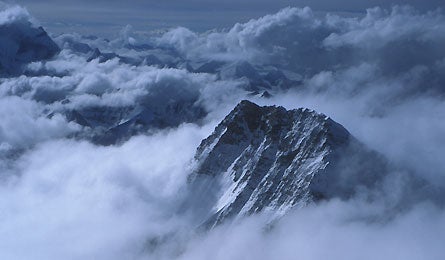Everest Contaminated by Toxic Metals

'The view of Changtse from Mount Everest. (Photo by Bill Yeo)'
Pure as the driven snow? Not so much, at least on Mount Everest. In the fall 2010 issue of Soil Survey Horizons, researchers from the University of Southern Maine reported that the mountain’s snow and soil—which climbers, Sherpas, and villagers drink and inhale every day via meltwater and windblown dust—contain possibly dangerous levels of the trace metals arsenic and cadmium.
In 2006, the study’s lead researcher Bill Yeo climbed along Everest’s Rongbuk Glacier and up the Northeast Ridge (one of the main routes to the summit), collecting soil and snow samples and testing their trace-element concentrations. The results were eye-opening. All of the samples had arsenic levels that exceeded the maximum contaminant level (MCL) set by the U.S. Environmental Protection Agency—with some samples containing five times the limit.
Cadmium levels were likewise above EPA guidelines in all of the snow samples, but fell below detectable limits in the soil. Other trace elements, such as mercury and lead, were at acceptable levels.
The researchers suspect that industrial air pollution—particularly from the combustion of fossil fuels and the production of nonferrous metals—in India and central Asia are largely to blame, since the arsenic and cadmium concentrations were higher than you would expect to see solely from natural, nonhuman sources (such as rock deposits and dust storms). Furthermore, other studies have indicated that high-elevation, tropospheric winds can carry trace metals in air pollution more than 1,500 miles. Ultra-tall peaks like Everest then act as a “‘catcher’s mitt’ for deposition,” the researchers write.
The results raise concerns for Everest mountaineers, who typically melt snow over their camp stoves for water. “Because climbers consume approximately 6 to 8 liters of water a day for an average of six days while camping at the North Col [on the northeast ridge] and above, there is potential for cadmium and arsenic to accumulate in climbers after ingesting melted snow,” the report concludes.
What’s more, strong winds regularly kick up contaminated dust, which people can then inhale or, if it lands on their food, ingest. “From base camp to advanced base camp winds carrying dust and dirt periodically scour eyes and skin, reducing visibility and leaving dust deposits in the mouth,” Yeo describes. “Fine particles driven by wind often penetrate the seams of tents, depositing a visible layer of dust on clothing, equipment, and food.”
For these reasons, the researchers recommend that Everest climbers protect themselves by wearing dust masks on windy days and by not melting snow for water.
Samantha Langley-Turnbaugh, PhD, the study’s co-author, says there are no published studies on how much the measured levels of arsenic and cadmium affect your health. But chronic ingestion of arsenic, a known human carcinogen, has been linked to cancer of the bladder, lungs, skin, kidneys, and liver. The EPA lists cadmium as a probable human carcinogen associated with lung and prostate cancer.
The findings concern more than Everest climbers, however. About one-tenth of the world’s population depends on fresh water from mountain snowpack. And conditions on Everest likely serve as a model for the deposition occurring on surrounding peaks with different watersheds.
In the United States, the USM researchers are now looking at soils in Maine’s mountains and have “found elevated levels of contaminants,” says Langley-Turnbaugh, “but that work is not published yet.” According to the EPA, in general, Western states are more likely than ones in the East to have water sources (particular groundwater) with heavy-metal concentrations exceeding limits, though hot spots exist throughout the country. By law, however, public water systems must regulate toxin levels in drinking water. Still, this doesn’t protect backpackers and hikers who drink directly from streams and lakes, so here are a few tips to minimize your exposure:
* Avoid drinking water from sources downstream from mines, mine tailings, or industrial areas, since they often have high levels of toxic metals.
* Find out the water quality for your backpacking destination at the EPA’s Watershed Assessment, Tracking, and Environmental Results site. This valuable database lets you look up the status (impaired or good) and specific contaminants for individual water bodies.
* If camping in a hot spot, pack in water or use a filter instead of just boiling your water. Although most portable filters remove only minimal amounts of heavy metals, the carbon components will help reduce other pollutants, along with, of course, biological pathogens like giardia.
* Don’t fret. Since most backpackers are only in the backcountry for a short period of time, the chances of health effects from chronic exposure are likely small.